Module 8 Story time Unit 3 Language in use课件 (共32张PPT)
文档属性
| 名称 | Module 8 Story time Unit 3 Language in use课件 (共32张PPT) |  | |
| 格式 | pptx | ||
| 文件大小 | 1.9MB | ||
| 资源类型 | 教案 | ||
| 版本资源 | 外研版 | ||
| 科目 | 英语 | ||
| 更新时间 | 2022-02-13 10:32:54 | ||
图片预览

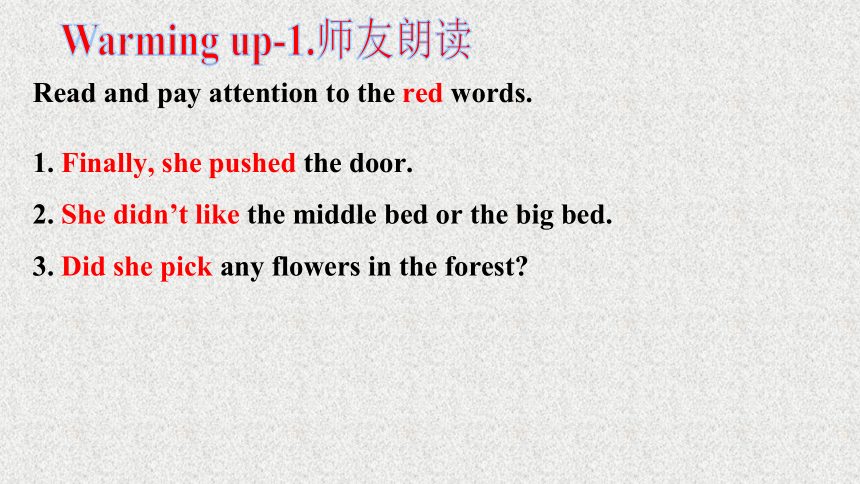
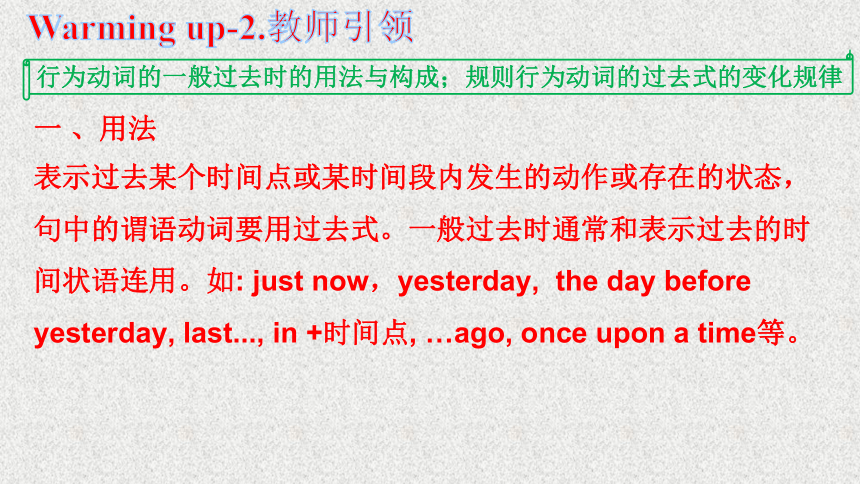


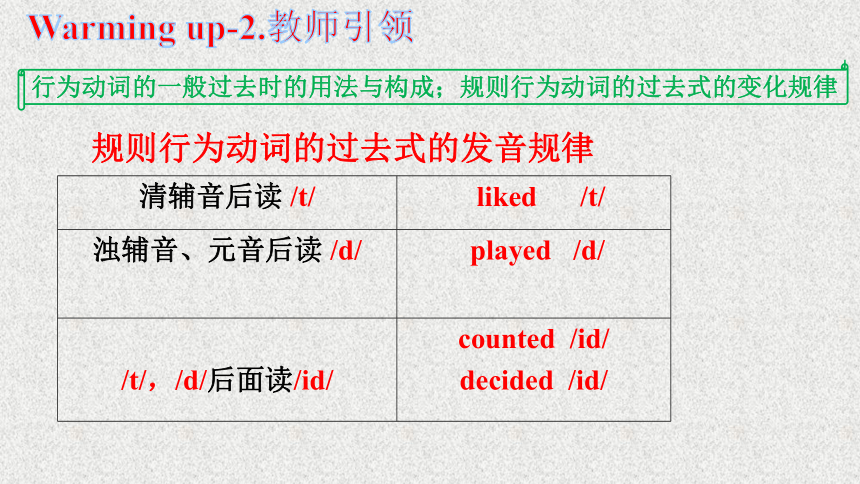


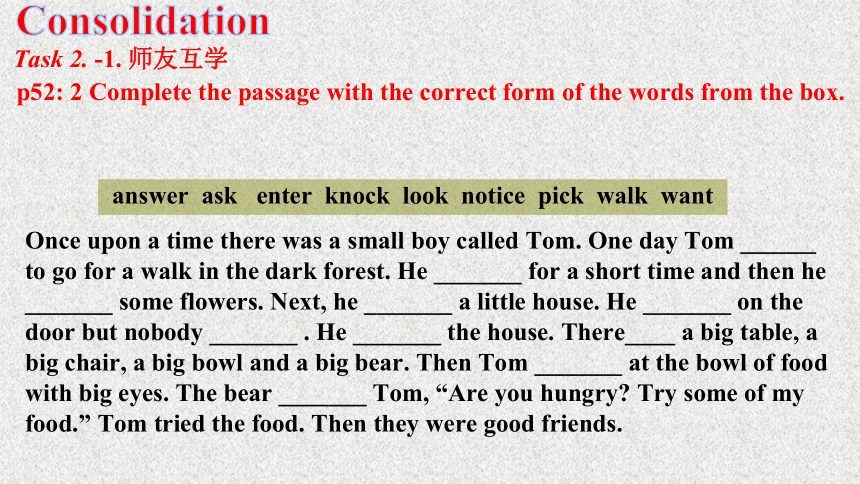
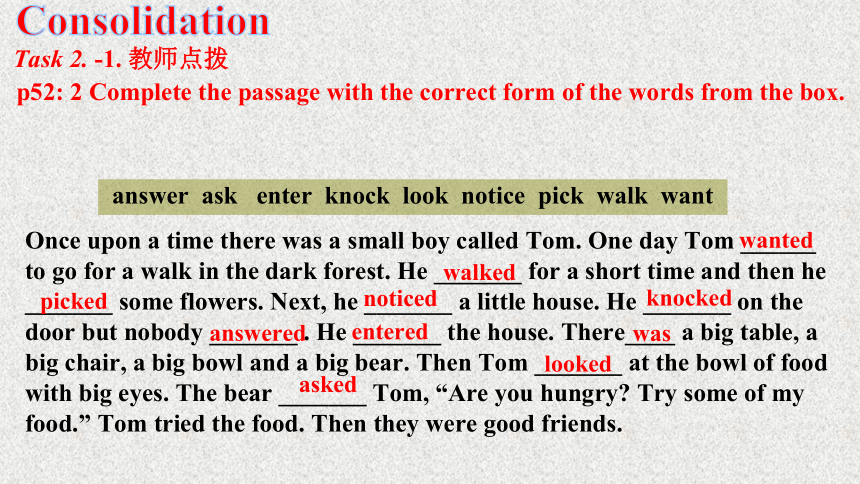
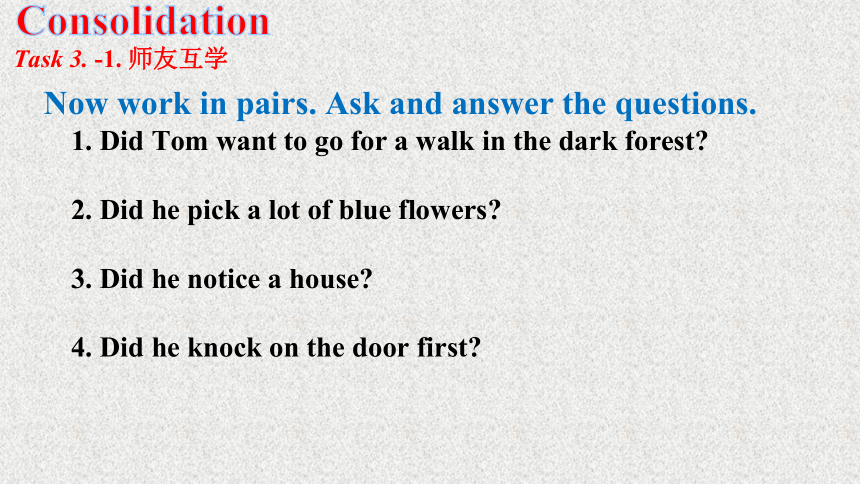
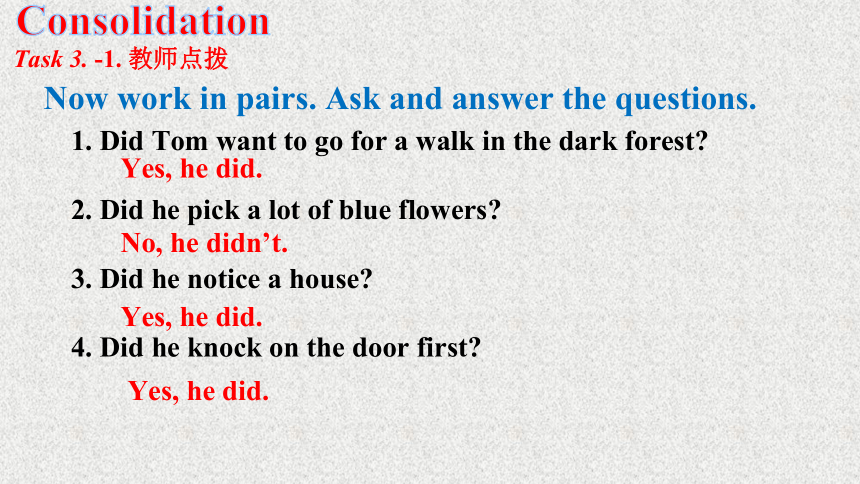
文档简介
(共32张PPT)
Module 8 Story time
Unit 3 Language in use
(Grammar)
Warming up-1.师友朗读
1. Finally, she pushed the door.
2. She didn’t like the middle bed or the big bed.
3. Did she pick any flowers in the forest
Read and pay attention to the red words.
行为动词的一般过去时的用法与构成;规则行为动词的过去式的变化规律
Warming up-2.教师引领
一 、用法
表示过去某个时间点或某时间段内发生的动作或存在的状态,句中的谓语动词要用过去式。一般过去时通常和表示过去的时间状语连用。如: just now,yesterday, the day before yesterday, last..., in +时间点, …ago, once upon a time等。
二、构成
1. 肯定句:主语 + 行为动词的过去式 + 其他.
2. 否定句:主语 + didn’t + 动词原形 + 其他.
3. 一般疑问句式:Did + 主语 + 动词原形 + 其他?
肯定回答:Yes, 主语 + did.
否定回答:No, 主语 + didn’t.
Warming up-2.教师引领
行为动词的一般过去时的用法与构成;规则行为动词的过去式的变化规律
Warming up-2.教师引领
动词原形 过去形式
walk listen walked
listened
live notice lived
noticed
hurry study hurried
studied
stop shop stopped shopped
三、规则行为动词的过去式的变化规律
1. 一般情况下,在动词原形后直接加-ed;
2. 以不发音的字母-e结尾的动词后加-d;
3. 以辅音字母加-y结尾的动词,变y为i,再加-ed;
4. 以一个辅音字母结尾的重读闭音节动词,先双写该辅音字母,再加-ed。
行为动词的一般过去时的用法与构成;规则行为动词的过去式的变化规律
清辅音后读 /t/ liked /t/
浊辅音、元音后读 /d/ played /d/
/t/,/d/后面读/id/ counted /id/
decided /id/
规则行为动词的过去式的发音规律
行为动词的一般过去时的用法与构成;规则行为动词的过去式的变化规律
Warming up-2.教师引领
answer enter hurry jump like notice point return try
1. Baby bear ________ to the girl in his bed.
2. She ________ the house.
3. Goldilocks ________ out of bed.
4. She ________ to the little house.
5. The three Bears didn’t ________ the door because they were out in the forest.
6. The three Bears didn’t ________ Goldilocks in bed at first.
7. Goldilocks didn’t ________to that part of the forest again.
8. —Did she ________ the small chair first
—No, she didn’t. She tried the big chair first.
9. — Did she ________ the small bed —Yes, she did.
p52: 1 Complete the sentences with the correct form of the words from the box.
Consolidation
Task 1. -1. 师友互学
answer enter hurry jump like notice point return try
1. Baby bear ________ to the girl in his bed.
2. She ________ the house.
3. Goldilocks ________ out of bed.
4. She ________ to the little house.
5. The three Bears didn’t ________ the door because they were out in the forest.
6. The three Bears didn’t ________ Goldilocks in bed at first.
7. Goldilocks didn’t ________to that part of the forest again.
8. —Did she ________ the small chair first
—No, she didn’t. She tried the big chair first.
9. — Did she ________ the small bed —Yes, she did.
pointed
entered
p52: 1 Complete the sentences with the correct form of the words from the box.
jumped
hurried
answer
notice
return
try
like
Consolidation
Task 1. -2. 教师点拨
p52: 2 Complete the passage with the correct form of the words from the box.
answer ask enter knock look notice pick walk want
Once upon a time there was a small boy called Tom. One day Tom ______ to go for a walk in the dark forest. He _______ for a short time and then he _______ some flowers. Next, he _______ a little house. He _______ on the door but nobody _______ . He _______ the house. There____ a big table, a big chair, a big bowl and a big bear. Then Tom _______ at the bowl of food with big eyes. The bear _______ Tom, “Are you hungry Try some of my food.” Tom tried the food. Then they were good friends.
Consolidation
Task 2. -1. 师友互学
p52: 2 Complete the passage with the correct form of the words from the box.
answer ask enter knock look notice pick walk want
Once upon a time there was a small boy called Tom. One day Tom ______ to go for a walk in the dark forest. He _______ for a short time and then he _______ some flowers. Next, he _______ a little house. He _______ on the door but nobody _______ . He _______ the house. There____ a big table, a big chair, a big bowl and a big bear. Then Tom _______ at the bowl of food with big eyes. The bear _______ Tom, “Are you hungry Try some of my food.” Tom tried the food. Then they were good friends.
wanted
walked
picked
noticed
knocked
answered
entered
was
looked
asked
Consolidation
Task 2. -1. 教师点拨
1. Did Tom want to go for a walk in the dark forest
2. Did he pick a lot of blue flowers
3. Did he notice a house
4. Did he knock on the door first
Now work in pairs. Ask and answer the questions.
Consolidation
Task 3. -1. 师友互学
1. Did Tom want to go for a walk in the dark forest
2. Did he pick a lot of blue flowers
3. Did he notice a house
4. Did he knock on the door first
Now work in pairs. Ask and answer the questions.
Yes, he did.
No, he didn’t.
Yes, he did.
Yes, he did.
Consolidation
Task 3. -1. 教师点拨
All around the world parents tell their children fairy tales. The stories are exciting and children enjoy listening to them again and again. In the stories, animals often speak and sometimes people become animals. The stories usually begin with “Once upon a time….”
Fairy tales (童话故事)
Around the world
Extension
p53: 3 Work in pairs. Look at the pictures and make sentences. At last put the sentences together to make a story. Use the words given.
Extension
The father loved his daughter very much.
The father and his daughter played games in the garden and they were very happy.
The little girl fell into the sea and died.
She changed into a bird called Jingwei.
Her father watched the bird and was sad.
The bird decided to fill the sea with stones(石头).
fill … with … 用……填满……
Once upon a time, there was a little girl called Nüwa. Her father was Emperor(皇帝) Yan and he loved his daughter very much. They played in the garden and were very happy. One day, Nüwa took a boat to the sea. She fell into the water and died. Then she changed into a bird called Jinwei. The Emperor Yan watched the bird and he was sad. Finally, the bird decided to fill the sea with stones.
Possible version:
Once upon a time there (1)_______ (be) a farmer. He didn’t like to work. One day, he (2)_______ (work) in his field. He was very tired and he (3)_______(walk) to a big tree. He (4)_______(notice) a hare running and it hit(撞) the tree. It (5)________ (die). He (6)_______ (hurry) home with the dead hare and had a good meal. The next day, he (7)_______ (want) another hare. So he (8)_______ (wait) under the tree and (9)_______ (plan) to pick up another, but he (10)_________ (pick) none.
用所给动词的适当形式填空。
Extension
Task 1. -1. 师友互学
Once upon a time there (1)_______ (be) a farmer. He didn’t like to work. One day, he (2)_______ (work) in his field. He was very tired and he (3)_______(walk) to a big tree. He (4)_______(notice) a hare running and it hit(撞) the tree. It (5)________ (die). He (6)_______ (hurry) home with the dead hare and had a good meal. The next day, he (7)_______ (want) another hare. So he (8)_______ (wait) under the tree and (9)_______ (plan) to pick up another, but he (10)_________ (pick) none.
was
worked
walked
noticed
died
hurried
wanted
waited
planned
picked
用所给动词的适当形式填空。
Extension
Task 2. -2. 教师点拨
完成句子。
他指向花园里的花。
He _______ _______ the flowers in the garden.
2. 因为有一条蛇, 小明从床上跳了起来。
Xiaoming _______ _______ _______ the bed because there was a snake.
3. 一个学生为我捡起了包。
A student _______ _______ the bag for me.
4. 我们向周围看了一下, 但是没有看到任何东西。
We _______ _______ but didn’t see anything.
Extension
Task 2. -1. 师友互学
完成句子。
他指向花园里的花。
He _______ _______ the flowers in the garden.
2. 因为有一条蛇, 小明从床上跳了起来。
Xiaoming _______ _______ _______ the bed because there was a snake.
3. 一个学生为我捡起了包。
A student _______ _______ the bag for me.
4. 我们向周围看了一下, 但是没有看到任何东西。
We _______ _______ but didn’t see anything.
jumped out of
picked up
looked around
pointed at
Extension
Task 2. -2. 教师点拨
根据括号内的要求完成下列各题。
1. I play football on Friday.(用last Friday改写句子)
I ______________ football last Friday.
2. Tom had breakfast this morning.(改为否定句)
Tom ______________ breakfast this morning.
3. Susan listened to music just now. (改为一般疑问句并补全肯定回答)
— _______________ to music just now
—Yes, _______________.
Extension
Task 3. -1. 师友练习
根据括号内的要求完成下列各题。
1. I play football on Friday.(用last Friday改写句子)
I ______________ football last Friday.
2. Tom had breakfast this morning.(改为否定句)
Tom ______________ breakfast this morning.
3. Susan listened to music just now. (改为一般疑问句并补全肯定回答)
— _______________ to music just now
—Yes, _______________.
played
didn’t have
Did Susan listen
she did
Extension
Task 3. -2. 教师点拨
Summarize
行为动词的一般过去时的用法与构成;规则行为动词的过去式的变化规律
一 、用法
表示过去某个时间点或某时间段内发生的动作或存在的状态,句中的谓语动词要用过去式。一般过去时通常和表示过去的时间状语连用。如: just now,yesterday, the day before yesterday, last..., in +时间点, …ago, once upon a time等。
Summarize
二、构成
1. 肯定句:主语 + 行为动词的过去式 + 其他.
2. 否定句:主语 + didn’t + 动词原形 + 其他.
3. 一般疑问句式:Did + 主语 + 动词原形 + 其他?
肯定回答:Yes, 主语 + did.
否定回答:No, 主语 + didn’t.
行为动词的一般过去时的用法与构成;规则行为动词的过去式的变化规律
Summarize
三、规则行为动词的过去式的变化规律
1. 一般情况下,在动词原形后直接加-ed;
2. 以不发音的字母-e结尾的动词后加-d;
3. 以辅音字母加-y结尾的动词,变y为i,再加-ed;
4. 以一个辅音字母结尾的重读闭音节动词,先双写该辅音字母,再加-ed。
行为动词的一般过去时的用法与构成;规则行为动词的过去式的变化规律
Summarize
清辅音后读 /t/ liked /t/
浊辅音、元音后读 /d/ played /d/
/t/,/d/后面读/id/ counted /id/
decided /id/
规则行为动词的过去式的发音规律
行为动词的一般过去时的用法与构成;规则行为动词的过去式的变化规律
读、记九模块一单元的单词。
Homework
Module 8 Story time
Unit 3 Language in use
(Grammar)
Warming up-1.师友朗读
1. Finally, she pushed the door.
2. She didn’t like the middle bed or the big bed.
3. Did she pick any flowers in the forest
Read and pay attention to the red words.
行为动词的一般过去时的用法与构成;规则行为动词的过去式的变化规律
Warming up-2.教师引领
一 、用法
表示过去某个时间点或某时间段内发生的动作或存在的状态,句中的谓语动词要用过去式。一般过去时通常和表示过去的时间状语连用。如: just now,yesterday, the day before yesterday, last..., in +时间点, …ago, once upon a time等。
二、构成
1. 肯定句:主语 + 行为动词的过去式 + 其他.
2. 否定句:主语 + didn’t + 动词原形 + 其他.
3. 一般疑问句式:Did + 主语 + 动词原形 + 其他?
肯定回答:Yes, 主语 + did.
否定回答:No, 主语 + didn’t.
Warming up-2.教师引领
行为动词的一般过去时的用法与构成;规则行为动词的过去式的变化规律
Warming up-2.教师引领
动词原形 过去形式
walk listen walked
listened
live notice lived
noticed
hurry study hurried
studied
stop shop stopped shopped
三、规则行为动词的过去式的变化规律
1. 一般情况下,在动词原形后直接加-ed;
2. 以不发音的字母-e结尾的动词后加-d;
3. 以辅音字母加-y结尾的动词,变y为i,再加-ed;
4. 以一个辅音字母结尾的重读闭音节动词,先双写该辅音字母,再加-ed。
行为动词的一般过去时的用法与构成;规则行为动词的过去式的变化规律
清辅音后读 /t/ liked /t/
浊辅音、元音后读 /d/ played /d/
/t/,/d/后面读/id/ counted /id/
decided /id/
规则行为动词的过去式的发音规律
行为动词的一般过去时的用法与构成;规则行为动词的过去式的变化规律
Warming up-2.教师引领
answer enter hurry jump like notice point return try
1. Baby bear ________ to the girl in his bed.
2. She ________ the house.
3. Goldilocks ________ out of bed.
4. She ________ to the little house.
5. The three Bears didn’t ________ the door because they were out in the forest.
6. The three Bears didn’t ________ Goldilocks in bed at first.
7. Goldilocks didn’t ________to that part of the forest again.
8. —Did she ________ the small chair first
—No, she didn’t. She tried the big chair first.
9. — Did she ________ the small bed —Yes, she did.
p52: 1 Complete the sentences with the correct form of the words from the box.
Consolidation
Task 1. -1. 师友互学
answer enter hurry jump like notice point return try
1. Baby bear ________ to the girl in his bed.
2. She ________ the house.
3. Goldilocks ________ out of bed.
4. She ________ to the little house.
5. The three Bears didn’t ________ the door because they were out in the forest.
6. The three Bears didn’t ________ Goldilocks in bed at first.
7. Goldilocks didn’t ________to that part of the forest again.
8. —Did she ________ the small chair first
—No, she didn’t. She tried the big chair first.
9. — Did she ________ the small bed —Yes, she did.
pointed
entered
p52: 1 Complete the sentences with the correct form of the words from the box.
jumped
hurried
answer
notice
return
try
like
Consolidation
Task 1. -2. 教师点拨
p52: 2 Complete the passage with the correct form of the words from the box.
answer ask enter knock look notice pick walk want
Once upon a time there was a small boy called Tom. One day Tom ______ to go for a walk in the dark forest. He _______ for a short time and then he _______ some flowers. Next, he _______ a little house. He _______ on the door but nobody _______ . He _______ the house. There____ a big table, a big chair, a big bowl and a big bear. Then Tom _______ at the bowl of food with big eyes. The bear _______ Tom, “Are you hungry Try some of my food.” Tom tried the food. Then they were good friends.
Consolidation
Task 2. -1. 师友互学
p52: 2 Complete the passage with the correct form of the words from the box.
answer ask enter knock look notice pick walk want
Once upon a time there was a small boy called Tom. One day Tom ______ to go for a walk in the dark forest. He _______ for a short time and then he _______ some flowers. Next, he _______ a little house. He _______ on the door but nobody _______ . He _______ the house. There____ a big table, a big chair, a big bowl and a big bear. Then Tom _______ at the bowl of food with big eyes. The bear _______ Tom, “Are you hungry Try some of my food.” Tom tried the food. Then they were good friends.
wanted
walked
picked
noticed
knocked
answered
entered
was
looked
asked
Consolidation
Task 2. -1. 教师点拨
1. Did Tom want to go for a walk in the dark forest
2. Did he pick a lot of blue flowers
3. Did he notice a house
4. Did he knock on the door first
Now work in pairs. Ask and answer the questions.
Consolidation
Task 3. -1. 师友互学
1. Did Tom want to go for a walk in the dark forest
2. Did he pick a lot of blue flowers
3. Did he notice a house
4. Did he knock on the door first
Now work in pairs. Ask and answer the questions.
Yes, he did.
No, he didn’t.
Yes, he did.
Yes, he did.
Consolidation
Task 3. -1. 教师点拨
All around the world parents tell their children fairy tales. The stories are exciting and children enjoy listening to them again and again. In the stories, animals often speak and sometimes people become animals. The stories usually begin with “Once upon a time….”
Fairy tales (童话故事)
Around the world
Extension
p53: 3 Work in pairs. Look at the pictures and make sentences. At last put the sentences together to make a story. Use the words given.
Extension
The father loved his daughter very much.
The father and his daughter played games in the garden and they were very happy.
The little girl fell into the sea and died.
She changed into a bird called Jingwei.
Her father watched the bird and was sad.
The bird decided to fill the sea with stones(石头).
fill … with … 用……填满……
Once upon a time, there was a little girl called Nüwa. Her father was Emperor(皇帝) Yan and he loved his daughter very much. They played in the garden and were very happy. One day, Nüwa took a boat to the sea. She fell into the water and died. Then she changed into a bird called Jinwei. The Emperor Yan watched the bird and he was sad. Finally, the bird decided to fill the sea with stones.
Possible version:
Once upon a time there (1)_______ (be) a farmer. He didn’t like to work. One day, he (2)_______ (work) in his field. He was very tired and he (3)_______(walk) to a big tree. He (4)_______(notice) a hare running and it hit(撞) the tree. It (5)________ (die). He (6)_______ (hurry) home with the dead hare and had a good meal. The next day, he (7)_______ (want) another hare. So he (8)_______ (wait) under the tree and (9)_______ (plan) to pick up another, but he (10)_________ (pick) none.
用所给动词的适当形式填空。
Extension
Task 1. -1. 师友互学
Once upon a time there (1)_______ (be) a farmer. He didn’t like to work. One day, he (2)_______ (work) in his field. He was very tired and he (3)_______(walk) to a big tree. He (4)_______(notice) a hare running and it hit(撞) the tree. It (5)________ (die). He (6)_______ (hurry) home with the dead hare and had a good meal. The next day, he (7)_______ (want) another hare. So he (8)_______ (wait) under the tree and (9)_______ (plan) to pick up another, but he (10)_________ (pick) none.
was
worked
walked
noticed
died
hurried
wanted
waited
planned
picked
用所给动词的适当形式填空。
Extension
Task 2. -2. 教师点拨
完成句子。
他指向花园里的花。
He _______ _______ the flowers in the garden.
2. 因为有一条蛇, 小明从床上跳了起来。
Xiaoming _______ _______ _______ the bed because there was a snake.
3. 一个学生为我捡起了包。
A student _______ _______ the bag for me.
4. 我们向周围看了一下, 但是没有看到任何东西。
We _______ _______ but didn’t see anything.
Extension
Task 2. -1. 师友互学
完成句子。
他指向花园里的花。
He _______ _______ the flowers in the garden.
2. 因为有一条蛇, 小明从床上跳了起来。
Xiaoming _______ _______ _______ the bed because there was a snake.
3. 一个学生为我捡起了包。
A student _______ _______ the bag for me.
4. 我们向周围看了一下, 但是没有看到任何东西。
We _______ _______ but didn’t see anything.
jumped out of
picked up
looked around
pointed at
Extension
Task 2. -2. 教师点拨
根据括号内的要求完成下列各题。
1. I play football on Friday.(用last Friday改写句子)
I ______________ football last Friday.
2. Tom had breakfast this morning.(改为否定句)
Tom ______________ breakfast this morning.
3. Susan listened to music just now. (改为一般疑问句并补全肯定回答)
— _______________ to music just now
—Yes, _______________.
Extension
Task 3. -1. 师友练习
根据括号内的要求完成下列各题。
1. I play football on Friday.(用last Friday改写句子)
I ______________ football last Friday.
2. Tom had breakfast this morning.(改为否定句)
Tom ______________ breakfast this morning.
3. Susan listened to music just now. (改为一般疑问句并补全肯定回答)
— _______________ to music just now
—Yes, _______________.
played
didn’t have
Did Susan listen
she did
Extension
Task 3. -2. 教师点拨
Summarize
行为动词的一般过去时的用法与构成;规则行为动词的过去式的变化规律
一 、用法
表示过去某个时间点或某时间段内发生的动作或存在的状态,句中的谓语动词要用过去式。一般过去时通常和表示过去的时间状语连用。如: just now,yesterday, the day before yesterday, last..., in +时间点, …ago, once upon a time等。
Summarize
二、构成
1. 肯定句:主语 + 行为动词的过去式 + 其他.
2. 否定句:主语 + didn’t + 动词原形 + 其他.
3. 一般疑问句式:Did + 主语 + 动词原形 + 其他?
肯定回答:Yes, 主语 + did.
否定回答:No, 主语 + didn’t.
行为动词的一般过去时的用法与构成;规则行为动词的过去式的变化规律
Summarize
三、规则行为动词的过去式的变化规律
1. 一般情况下,在动词原形后直接加-ed;
2. 以不发音的字母-e结尾的动词后加-d;
3. 以辅音字母加-y结尾的动词,变y为i,再加-ed;
4. 以一个辅音字母结尾的重读闭音节动词,先双写该辅音字母,再加-ed。
行为动词的一般过去时的用法与构成;规则行为动词的过去式的变化规律
Summarize
清辅音后读 /t/ liked /t/
浊辅音、元音后读 /d/ played /d/
/t/,/d/后面读/id/ counted /id/
decided /id/
规则行为动词的过去式的发音规律
行为动词的一般过去时的用法与构成;规则行为动词的过去式的变化规律
读、记九模块一单元的单词。
Homework
同课章节目录
- Module 1 Lost and found
- Unit 1 Whose bag is this?
- Unit 2 Are they yours?
- Unit 3 Language in use
- Module 2 What can you do ?
- Unit 1 I can play the piano
- Unit 2 I can run really fast
- Unit 3 Language in use
- Module 3 Making plans
- Unit 1 What are you going to do at the weekends?
- Unit 2 We're going to cheer the players.
- Unit 3 Language in use
- Module 4 Life in the future
- Unit 1 Everyone will study at home
- Unit 2 Every family will have a small plane.
- Unit 3 Language in use
- Module 5 Shopping
- Unit 1 What can I do for you?
- Unit 2 You can buy everything on the Internet
- Unit 3 Language in use
- Module 6 Around town
- Unit 1 Could you tell me how to get to the Nationa
- Unit 2 The London Eye is on your right.
- Unit 3 Language in use
- Revision module A
- Module 7 My past life
- Unit 1 I was born in a small village.
- Unit 2 I was born in Quincy.
- Unit 3 Language in use
- Module 8 Story time
- Unit 1 Once upon a time….
- Unit 2 Goldilocks hurried out of the house.
- Unit 3 Language in use
- Module 9 Life history
- Unit 1 He left school and began work at the age of
- Unit 2 He decided to be an actor.
- Unit 3 Language in use
- Module 10 A holiday journey
- Unit 1 What did you do?
- Unit 2 This morning we took a walk.
- Unit 3 Language in use
- Module 11 Body language
- Unit 1 They touch noses!
- Unit 2 Here are some ways to welcome them.
- Unit 3 Language in use
- Module 12 Western music
- Unit 1 It's so beautiful!
- Unit 2 Vienna is the centre of European classical
- Unit 3 Language in use
- Revision module B
